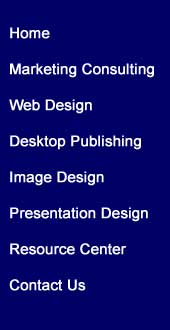


Home Web Design Desktop Publishing Image Presentations Translation Resources



Resource Center
Marketing plan essentials
Each company's marketing plan is unique and needs to be tailored to the specific needs of the organization. However, there are some essential standard components that a marketing plan ought to contain:
-
Situation Analysis: Normally this will include a market analysis, a SWOT analysis (strengths, weaknesses, opportunities, and threats), and a competitive analysis. The market analysis will include market forecast, segmentation, customer information, and market needs analysis.
Marketing Strategy: This should include at least a mission statement, objectives, and focused strategy including market segment focus and product positioning.
Sales Forecast: This would include enough detail to track sales month by month and follow up on plan-vs.-actual analysis. Normally a plan will also include specific sales by product, by region or market segment, by channels, by manager responsibilities, and other elements.
Expense Budget: This ought to include enough detail to track expenses month by month and follow up on plan-vs.-actual analysis. Normally a plan will also include specific sales tactics, programs, management responsibilities, promotion, and other elements. The expense budget is a bare minimum.
Developing Your Strategy
Marketing strategy is essentially
focus.You have too much to do with too few resources.
You therefore focus on specific target markets, on your most important
products or services, and on your most productive sales and marketing
activities.
Good marketing first identifies a market need and then fills that
need.
Market Research
Market research is the process of gaining information
about your
market. Preferably, this is specific information about your target
market and the key factors that influence their buying decisions. Market
research can be casual and limited in scope and, although it may not be
“statistically significant” research, it can still be valuable. The
value and “degree of fit” may be based on the quality, cost, or the
amount of time to acquire the information using these practical market
research tools.
Target Marketing
Your marketing budget is going to be most effective when it reaches
your selected target market. Target marketing is a better use of your
most valuable resources, i.e. time and money, to generate additional
revenue. The more you
know about your customers, the better you will be able to make decisions
that will enhance your ability to communicate and connect with them.
Also, look at competitors or
similar businesses in other markets to gain insight.
Market Analysis
- SWOT analysis.
The SWOT analysis covers strengths, weaknesses, opportunities, and
threats. Strengths and weaknesses are generally internal attributes,
which we can address by changing our business. Opportunities and threats
are generally external.
- Know Your Customers.
- Competitive analysis. Who competes with you for your customers' time and money? Are they selling directly competitive products and services, substitutes, or possible substitutes? What are their strengths and weaknesses? How are they positioned in the market? Consider their service, pricing, reputation, management, financial position, brand awareness, business development, technology, or other factors that you feel are important. In what segments of the market do they operate? What seems to be their strategy? How much do they impact your service business, and what threats and opportunities do they represent? A good competitive analysis varies according to what industry you're in and your specific marketing plan and situation.
-Target Segment Analysis. For each of your market segments, the market analysis should explain as much as possible about the target customers included in that group. That normally includes the segment description, needs and requirements, distribution channels, competitive forces, communications, and keys to success.
- Market Forecast. A market forecast is a core component of a market analysis. It projects the future numbers, characteristics, and trends in your target market. A standard analysis shows the projected number of potential customers divided into segments.
- Market Value. The market value is simple mathematics. Multiply the number of potential customers in the market by the average purchase per customer.
Pricing
Understand Your Pricing Choices. Before
you talk about pricing as strategy, or positioning, take a good hard
look at your real business situation. Not all businesses have the luxury
of setting their own prices.
Expense budget
Your Budget is a Marketing Tactic. Some
companies spend 50% of sales on marketing, some spend 10%, and some
spend nothing at all. Spending levels are strategic and tactical.
There are several benefits of creating and using a marketing budget:
-
The goal of your marketing budget is to control your expenses and project your revenues.
-
It also assists in the coordination of your marketing activities within your organization.
-
A realistic budget establishes a standard of performance for your actions, and communicates those standards to others responsible for implementing your marketing strategy.
-
A well-designed budget is also a tool to keep you on target and indicate when there is needed modification of your marketing plan - especially if something goes really right or very wrong.

Marketing resources
- Academy of International Business
- Academy of Management
- Academy of Marketing
- Academy of Marketing Science
- Advertising Research Foundation
- American Academy of Advertising
- American Association of Advertising Agencies
- American Management Association
- American Marketing Association
- American Statistical Association
- Association Française du Marketing
- Association for Consumer Research
- Association of Management / International Association of Management
- Association of Marketing Educators
- Business Marketing Association
- Direct Marketing Association
- E-Marketing Association
- EMAC, the European Marketing Academy
- ESOMAR, the European Society for Opinion and Marketing Research
- FEDMA, the Federation of European Direct Marketing
- Hospitality Sales and Marketing Association International
- International Advertising Association
- Internet Marketing Association
- Market Research Society
- Marketing Management Association
- Marketing Research Association
- Sales & Marketing Executives International
- Society for Marketing Professional Services
- Strategic Management Society
- World Marketing Association
Please report problems to Webmaster
Copyright Marketing Soup, 2002-2007